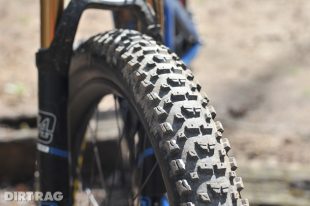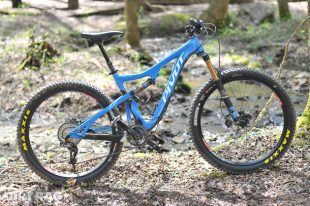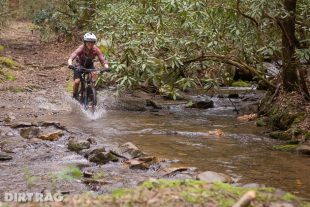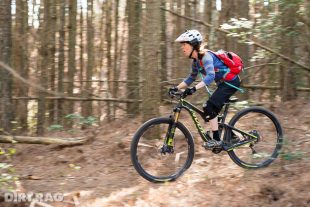First Ride: New Maxxis 27plus, 27.5 and 29 Inch Tires
Originally posted on April 11, 2016 at 7:00 amWords and photos: Emily Walley and Justin Steiner
The mountain bike market is a flurry of activity right now as frame, wheel and tire manufacturers strive to sort out where the current evolution and specialization of mountain bikes will end up. On one end of the spectrum, we have enduro bikes with descending capabilities that aren’t too far behind those of downhill bikes. Some of those bikes are even flirting with 27plus tire sizes. On the other end of the spectrum, we have 29plus and fat bikes that are being used for everything from bikepacking to crushing rowdy trails on fully rigid singlespeeds. Within the last year, manufacturers have thrown a lot of ideas on the wall to see what sticks.

In early April, Maxxis invited us to Mulberry Gap Mountain Bike Get-A-Way near Ellijay, Georgia, in order to check out the plethora of new tires it has launched within the last year to fill the broad spectrum of demand for new mountain bike tires.
Before we talk about specific tires, let’s touch on the development process. Manufacturing tires involves having a production mold cut from steel. This process is time consuming and extremely expensive, so it’s something Maxxis, and all tire manufacturers, strive to get right the first time.

Short of having this mold, there’s no way to produce a tire. In order to facilitate the design process, Maxxis engineers produce 3D-printed prototypes of a tire design in order to visualize the final product. This 3D-printed prototype is then shared with test riders, sales staff and OEM partners for feedback. This prototype might go through 2 to 3 revisions before a design is finalized and the mold cutting begins.
Perhaps the biggest (pun intended) story at the summit was the expansion of plus and fat bike offerings from Maxxis. In addition to some of the lighter, faster tires on offer from Maxxis, the company has recently announced burlier options in both 27plus and 29plus sizes utilizing some of its iconic tread patterns.
Maxxis’ position on 29plus trends on the larger end of the spectrum with size-accurate 29 x 3.0-inch versions of the Minion DHF and Minion DHR. In person these tires looked burly and way grippy. We’re curious to get our hands on samples to see how they roll. All that grip will likely come with the penalty of increased rolling resistance and weight, but Maxxis wasn’t willing to divulge weights since these tires we saw were pre-production samples.

27plus versions of the Minion DHF, Minion DHR, and High Roller II will be available in a 2.8 inch width. According to Maxxis, 2.8 inches is the sweet spot for tires that are designed to be ridden more aggressively, providing a good balance of air volume and casing stability. The tires also offer the benefit of fitting inside many existing 29 inch frames. Weights for all three of these tires will be 980 grams for 120 tpi versions and 1040 grams for 60 tpi models, which is impressive considering the 29 x 2.3 inch versions of these tires check in between 855 and 925 grams.
Fat bike riders looking for substantial rubber should rejoice in the new Minion fat bike offerings. The Minion FBF and Minion FBR are inspired by their narrower Minion siblings, promising to bring a bit more grip to the world of fat bikes. Weights range from 1225 grams to 1650 grams depending on size and technology featured.
In 2015, Maxxis also launched its DoubleDown casing construction to fill the gap between its tires with EXO sidewall protection and the dual-ply downhill tires. The tires target the hardcore enduro crowd where aggressive riders are looking for a tire that’s tougher than the EXO offerings but not as heavy as a dual-ply downhill tire.

Maxxis’ trail tires utilize a single-ply 60 tpi casing, where the downhill tires use a dual-ply of the same 60 tpi casing. The DoubleDown casing utilizes dual layers of 120 tpi casing and a butyl insert above the bead to protect from pinch flats. Even though it is a true dual-ply casing, DoubleDown splits the difference, both in terms of protection and weight, between the trail and downhill offerings.
In addition to the go-to Minion DHF, two new Maxxis tread patterns will be offered with DoubleDown construction: Aggressor and Tomahawk. We didn’t have a chance to sample the Tomahawk, but did get to ride the Aggressor in single-ply form. See riding impressions below.
Also new for 2015 is the Forekaster, offered only in 29 x 2.35 inch size for now. Billed as an aggressive XC tire, it looks very well suited to loose and wet trail conditions. The Forekaster tips the scale to 735 grams.
First Impressions
We weren’t able to sample all of Maxxis’ new tires, but here are our brief ride impressions on those we were able to ride.
Rekon 27.5 x 2.8


Ridden by Justin.
The Rekon is quickly establishing itself as a go-to plus tire for all-around trail use thanks to its balance of traction, weight, reasonable rolling resistance and resilience. On a brief ride aboard the Rekon, I was impressed by its traction during acceleration, braking and cornering. Only in wet turns did the Rekon begin to push the front and drift the rear, but always in a predictable fashion. At 780 to 825 grams, the Rekon is lighter or on par with many 2.3 inch wide tires in 27.5 and 29 inch diameters. The Pivot Mach 429 Trail felt faster, both uphill and down with these tires than the Aggressors in 29 x 2.3 inch.
Aggressor 29 x 2.3
Ridden by Justin.
The Aggressor is designed to be a heavy-duty tire for trail and enduro applications. Weights reflect that: 900 grams for the 29 inch EXO-reinforced single-ply and 1115 grams for the DoubleDown casing in the same size. On the trail, the Aggressor felt, well, aggressive. It bit hard in all situations, providing more than adequate traction. The only downside was that they felt heavier and slower than plus tires on the 429 Trail. The extra weight was noticeable both in climbing and when flicking the bike around during technical moves and in the air. Though I have no data to prove it, I felt faster and experienced a more comfortable ride aboard the plus tires on the 429 Trail.
Minion SS 27.5 x 2.3


Ridden by Emily.
Tested on the Pivot Mach 6 with the Minion DHF on the front and the Minion SS on the rear. The SS is generally ridden as a rear tire. A center of short, cross-country-style knobs are nestled between chunky Minion side knobs, giving the tire a boxy look. My perception was that this tire would slide around on the rear, but that wasn’t the case. The large side knobs offered ample cornering traction and the square profile was fast rolling on Mulberry Gap’s, moderately technical, Bear Creek trail. The SS saved 95 grams over running a Minion DHF on the rear. The weight savings was worthwhile on this trail, where the extra traction of a DHF wasn’t essential. However, in more aggressive terrain I’d likely opt for the extra weight of a DHF or DHR.
High Roller II 27.5 x 2.8


Ridden by Justin.
I’m a big fan of the High Roller II, so I was stoked to see and sample this tread pattern in 27plus, even in pre-production form. This chunky tire looks mean in the 2.8 inch width and feels incredibly competent on the trail. Pivot’s 429 Trail is a very capable bike, but the High Roller II felt almost like overkill for both the bike and then relatively smooth trails we traveled. Where the Rekon felt more use-appropriate on the 429 Trail, the plus-sized High Roller II begs for more travel, chunky technical terrain and a hard-charging rider. Despite the High Roller II’s hefty appearance, it felt more nimble and seemed to roll at least as well as, if not better than, the Aggressor on the 429 Trail. Not only that, but there’s only an 80 to 104 gram weight penalty compared to the lightest Aggressor. Aired up to 15-16 psi in the front and 18-19 psi in the rear, as recommended by Pivot President and CEO Chris Cocalis, I wasn’t able to discern any tire squirm or other strange handling characteristics during our brief ride. Though more testing is required, this tire setup shows a lot of promise for aggressive riding in rough terrain.
Ardent Race 29 x 2.2


Ridden by Emily.
On the 100 mm travel Pivot Mach 429SL, this medium tread tire was about perfect on Georgia’s non-technical Pinhoti 2 and 3, which involved a fair bit of climbing before hitting a rewarding downhill. The Ardent Race tires were quick to climb and capable on the descents, offering a balance of fast rolling speed and plenty of grip on loose terrain. The Ardent Race tread falls between the lightweight Ikon and the more aggressive Ardent.